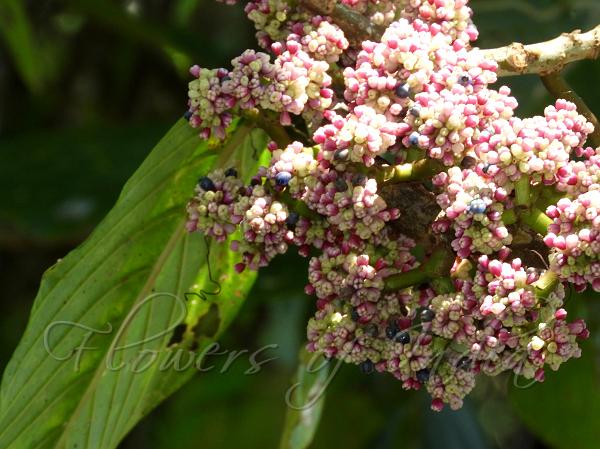|
| Fragrant Conehead |
|

|

| File size | 758418 |
| Original date | 4/24/19 10:43 AM |
| Resolution | 5184 x 3888 |
| Flash | Flash fired, auto, red-eye reduction |
| Focal length | 71.7mm |
| Exposure time | 1/125s |
| Aperture | 5.6 |
| Focus Distance | |
| Metering Mode | Multi-segment |
| Camera make | NIKON |
| Camera model | COOLPIX B700 |
| Sensor type |
|
|
|
|
Photo: |
Botanical name: Poikilospermum suaveolens Family: Urticaceae (Nettle family)
Synonyms: Covellia grandifolia, Conocephalus suaveolens
Synonyms: Covellia grandifolia, Conocephalus suaveolens
Fragrant Conehead is a large evergreen climber with
woody stem. Male inflorescences are symmetrically branched 2-3 times,
3.5-6 x 3-7 cm; bracts boat-shaped, 6-10 mm; glomerules 5-7 mm in
diameter. Female inflorescences are symmetrically branched 1 or 2
times, 4-8 x 5-9 cm; primary flower-cluster-stalk longer than
secondary; bracts as males; glomerules 2.5-3.5 cm in diameter, 3.5-5 cm
in diameter in fruit. Male flowers are stalkless, obovoid, 1.5-2 mm;
tepals 4, tip incurved, velvet-hairy; stamens 4; filaments straight,
short. Female flowers have flower-stalk 3-7 mm; stigma shortly
strap-shaped. Branchlets are gray-brown when dry; velvet-hairy, soon
hairless. Stipules are often persistent in upper nodes, strongly
crescent-shaped, 2-4 cm. Leaf-stalks are 5-10 cm, leaf blade broadly
ovate, elliptic, or obovate, 10-35 x 7-23 cm, lateral veins 7-14 pairs,
both surfaces hairless, base broad wedge-shaped, rounded, or
heart-shaped, tip blunt or pointed.Achene oblong-obovoid, 3-5 mm,
verrucose. Fragrant Conehead is found in moist places, rain forests,
monsoon forests, near streams, at altitudes of 500-600 m, in East
Himalayas, SE Asia and Andaman and Nicobar. Flowering: April-May.
| Identification credit: Momang Taram | Photographed in Pasighat, Arunachal Pradesh. |
• Is this flower misidentified? If yes,